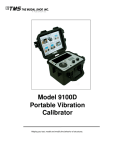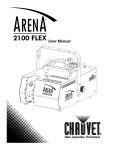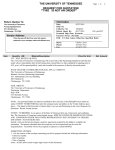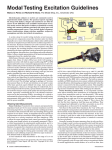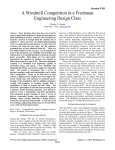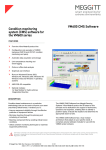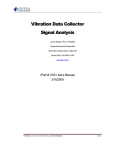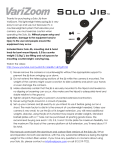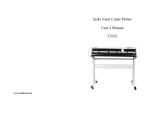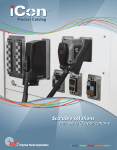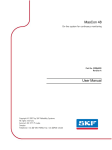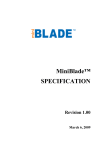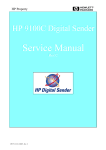Download Model 9100C Portable Vibration Calibrator
Transcript
Model 9100C Portable Vibration Calibrator Helping you test, model and modify the behavior of structures. The Modal Shop, Inc. 9100C User Manual MODEL 9100C Portable Vibration Calibrator User Manual 3149 East Kemper Road Cincinnati, OH 45241 Phone: 513.351.9919 FAX: 513.458.2172 www.modalshop.com Product Support For answers to questions about the 9100C Portable Vibration Calibrator, consult this manual. For additional product support, contact The Modal Shop at 800-860-4867 or 513-351-9919, 9 a.m. to 5 p.m. EST. If it is more convenient, fax questions or comments to The Modal Shop at 513- 458-2172 or email our sales staff at [email protected]. Warranty The Modal Shop, Inc. products are warranted against defective materials and workmanship for ONE YEAR from the date of shipment, unless otherwise specified. Damage to equipment caused by incorrect power, misapplication, or procedures inconsistent with this manual are not covered by warranty. If there are any questions concerning the intended application of the product, contact an Applications Engineer. Batteries and other expendable accessory hardware items are excluded. Copyright Copyright © 2009 the Modal Shop, Inc. This manual is copyrighted with all rights reserved. The manual may not be copied in whole or in part for any use without prior written consent of The Modal Shop, Inc. Disclaimer The following paragraph does not apply in any state or country where such statements are not agreeable with local law: The Modal Shop, Inc. provides this publication “as is” without warranty of any kind, express or implied, including but not limited to, the implied warranties of merchantability or fitness for a particular purpose. This document is subject to change without notice, and should not be construed as a commitment or representation by The Modal Shop, Inc. This publication may contain inaccuracies or typographical errors. The Modal Shop, Inc. will periodically update the material for inclusion in new editions. Changes and improvements to the product described in this manual may be made at any time. Trademarks ® ICP is a registered trademark of PCB Group, Inc. MAN-0031 Rev F July 6, 2009 MAN-0031 rev F Page 2 of 20 800-860-4867 The Modal Shop, Inc. 9100C User Manual Table of Contents INTRODUCTION.............................................................................................................................. 4 Welcome ............................................................................................................................. 4 Customer Support ............................................................................................................... 4 Cautionary Notes ................................................................................................................ 4 Transportation ..................................................................................................................... 5 Shipping .............................................................................................................................. 5 Optional Fixturing and Accessories .................................................................................... 5 THEORY OF OPERATION.............................................................................................................. 6 Instrumentation ................................................................................................................... 6 Battery and Charger............................................................................................................ 7 Warning! .......................................................................................................................7 Special Handling/Storage ............................................................................................. 7 OPERATION.................................................................................................................................... 8 Cautionary Notes ................................................................................................................ 8 Operating Steps .................................................................................................................. 8 Typical Sensor/Fixture Payloads ........................................................................................ 9 Helpful Suggestions ............................................................................................................ 9 Using The Reference Accelerometer................................................................................ 10 SPECIFICATIONS AND PERFORMANCE................................................................................... 11 Accuracy ........................................................................................................................... 11 Shaker Resonance............................................................................................................ 11 Shaker Loading .................................................................................................................12 RECOMMENDED PRACTICES .................................................................................................... 13 Operation Check and Recalibration .................................................................................. 13 Standard Checks For Transducers ................................................................................... 13 Typical Accelerometer Checkout................................................................................ 13 Typical Velocity Sensor Checkout.............................................................................. 14 Cable and Connector Check............................................................................................. 14 Non-Contact Displacement Sensor Calibration ................................................................ 14 Non-Contact Displacement Sensor Test Setup ................................................................ 15 Non-Contact Displacement Sensor Frequency Response Check.................................... 19 Non-Contact Displacement Sensor Linearity Check......................................................... 19 Maintenance...................................................................................................................... 20 Declaration of Conformance ............................................................................................. 20 MAN-0031 rev F Page 3 of 20 800-860-4867 The Modal Shop, Inc. 9100C User Manual Introduction Welcome Thank you for choosing TMS Model 9100C. The TMS Model 9100C Portable Vibration Calibrator (PVC) provides a field tested method for on-the-spot dynamic verification of accuracy. Accelerometers, velocity pickups and non-contact displacement transducers are accommodated. Optional fixtures and hardware needed to facilitate mounting most transducers to the vibrating shaker head are available upon request. The 9100C incorporates a built-in sine wave oscillator, power amplifier, electromagnetic shaker, NIST traceable reference accelerometer, digital display, batteries, and external power supply/charger. The 9100C is a completely self contained unit that operates on battery or AC power. The built-in reference accelerometer is attached permanently to the shaker armature. This maximizes the accuracy between the reference accelerometer and the test transducer. The 9100C is designed to provide long term reliable performances over the frequency range of 30 Hz to 10 kHz. The 9100C can be used for a variety of applications that include: • Verification and Calibration of vibration transducers and related test systems. • Verification of connector and cabling integrity. • Verification of speed indicator measuring systems. Customer Support The Modal Shop, Inc. is a PCB Group Company, and we are 100% committed to the PCB Group’s pledge of ‘Total Customer Satisfaction’. If at any time you have questions or problems with the 9100C system, please contact an applications engineer at The Modal Shop by any of the following: Telephone: Toll Free: Fax: Email: 513-351-9919 800-860-4TMS (4867) 513-458-2172 [email protected] Cautionary Notes • Loads of up to 750 grams (26.5 ounces) can be mounted directly to the shaker head. Larger loads may be applied to the shaker head, however, if prolonged testing of a heavy load is planned, we recommend using an external transducer suspension system. Under these conditions the vibration waveform should be viewed on the oscilloscope to aid in positioning the test transducer and shaker head to reduce distortion that can occur with very large weights. • The 9100C should always be operated on a stable flat surface • The 9100C is designed for field test applications but care must be exercised in order to maintain the integrity of the shaker head assembly. MAN-0031 rev F Page 4 of 20 800-860-4867 The Modal Shop, Inc. 9100C User Manual Transportation When transporting the 9100C, care should be taken to ensure that sudden impacts are minimized. Any motion of the shaker head that might put abnormal vertical displacement or side loading should be minimized. Shipping When transporting the 9100C via commercial carrier, care should be taken to insure that sudden impacts will be minimized. Any motion of the shaker head that might exert abnormal vertical displacement or side loading can damage the flexure system. The original shipping box is packed with sufficient foam to provide a good cushion for normal transportation environments. DO NOT USE GROUND TRANSPORT SYSTEMS THAT MACHINE SORT CARGO. Use FEDX, UPS Next Day or 2nd Day Air. Do not use UPS Ground! Optional Fixturing and Accessories For operation in certain applications, such as calibration of non-contact displacement sensors, TMS offers optional mounting fixturing. Reference the table below when ordering these optional adapters and accessories. MAN-0031 rev F Accessory Description S4A-1 Non-contact displacement sensor holder, with micrometer and target. S4A-2 Steel target, non-contact displacement sensor calibration S4A-3 Universal transducer adapter, circular plate for custom mounting holes to be drilled and tapped by user. S4A-4 Screw adapter kit, includes: • Stud adapter, 6-32 internal thread, ¼ external thread • Mounting stud, 10-32 to ¼-28 x 0.30” long, BeCu • Mounting stud, ¼-28 to ¼-28 x 0.365” long BeCu w/ shoulder S4A-5 Ruggedized transportation case S4A-6 Power supply / charger S4A-7 Replacement battery Page 5 of 20 800-860-4867 The Modal Shop, Inc. 9100C User Manual Theory of Operation Instrumentation The Model 9100C Portable Vibration Calibrator (PVC) electrical system is comprised of several different mechanisms. • Digital Voltmeter • Digital Frequency Indicator • Power Amplifier • Electromagnetic Shaker • Reference Accelerometer • Signal Generator Also included are batteries and an external charger discussed in the following section. A digital voltmeter and frequency indicator are especially designed for the 9100C that continuously reads vibration level and frequency on the front panel digital displays. The power amplifier is specially designed to provide the current required to drive the coil of the electromagnetic shaker The reference accelerometer measures the level of vibration at the shaker head. The reference accelerometer, an integral part of the shaker head, incorporates a piezoelectric ceramic crystal, which has an output proportional to vibration. This signal is conditioned, buffered and sent to the BNC connector on the front panel. The sensitivity at the BNC is factory calibrated to 50 mV/g. A calibration “standard” MAN-0031 rev F Page 6 of 20 800-860-4867 The Modal Shop, Inc. 9100C User Manual is maintained by TMS that is used to calibrate the 9100C and maintain NIST traceability. The signal generator produces a variable frequency sine wave, which becomes the source of the driving signal to produce the vibration at the shaker head. The amplitude of this sine wave signal is controlled by the front panel AMPLITUDE control. The frequency is also controlled by the front panel FREQUENCY control. The vibration levels can be read in English or Metric units set by a front panel switch. Frequency is read in Hz. Battery and Charger The Model 9100C can be operated from AC line power or from its internal rechargeable batteries. When the external power supply is connected, it becomes the primary power source operating the unit as well as charging the battery. Battery power is supplied by a sealed solid gel lead acid 12 VDC rechargeable battery. The battery is designed for continuous charging without damage. Keeping the battery with full charge means the 9100C will be ready when needed. Under normal operation the 9100C will operate in excess of 4 hours with a fully charged battery. Charge life is directly dependent on the power used. When testing requires high forces to drive the test transducer, the charge life will be shortened. Warning! A COMPLETE DISCHARGE WILL MOST LIKELY CAUSE BATTERY FAILURE. When the “Bat” battery indication is seen on the display, switch over to AC power. If the warning is given again TURN THE UNIT OFF!! Under normal conditions the battery will obtain a full charge with 2-4 hours of charge time. For every hour of discharge, the unit must charge for 1.5 hours. If deep discharge occurs, 2 or more days may be required to reach full charge. If the battery can not reach adequate charge, replacement batteries (S4A-7) are available. Special Handling/Storage The internal battery should provide long-term service under normal operating conditions. The units are securely mounted so that no damage can occur from shipping or normal transportation. No special handling should be required. TMS does not recommend that the battery be removed for shipping or storage for periods less than three (3) months. However, it is recommended that the unit be kept “on charge” when in storage. MAN-0031 rev F Page 7 of 20 800-860-4867 The Modal Shop, Inc. 9100C User Manual Operation Cautionary Notes ALWAYS USE A WRENCH TO HOLD THE SHAKER HEAD WHEN CHANGING THE TEST SPECIMEN The end user is encouraged to take every precaution to ensure that the 9100C is not misused. Overloading the unit for extended periods at high amplitudes is strongly discouraged. Following these precautions will help prolong the life of the vibrator sub-assembly. As long as the displacement limits of the vibrator are not exceeded, the full power of the amplifier can be used to drive the shaker. If the 9100C is being used to test a large load, the amplitude limit must not be reached. When relatively light loads are being tested at lower frequencies, care should be taken to avoid repetitive contact with the limit stops. Continual hitting of the limits will result in damage to the moving elements and an increase in distortion. The care given when mounting a test transducer to the shaker head often has a direct influence on the accuracy of the calibration. In fact, improper mounting can lead to erroneous readings and may cause damage to the test transducer and/or the 9100C. When tightening or removing a test transducer, hold the shaker head with the wrench to prevent a circumference torque from being applied to the shaker suspension system. The Model 9100C is more vulnerable to “twisting” damage than any other abuse. When applying torque, do not exceed twenty inch pounds. IF THE TONE OF THE UNIT CHANGES WHEN THE AMPLITUDE IS INCREASED, THE SHAKER IS BEING OVERDRIVEN. DO NOT DRIVE THE DISPLACEMENT AMPLITUDE SO HIGH THAT THE ELEMENT “BANGS” THE STOPS. DON’T FORGET TO TURN THE 9100C OFF. PLUG IN THE CHARGER WHEN FINISHED. The batteries are sealed, solid gel, lead acid, and like to be charged when at rest. It is advisable to keep the unit on charge when not in use. Operating Steps The operator can set the 9100C to display data in English or Metric units. 1. Set the Amplitude Function switch according to the type of transducer being checked. Sensor Type 9100C Setting Display Units Accelerometer ACC g peak Velocity VEL ips peak Displacement DISP mils peak to peak Make sure the Amplitude Adjustment control is turned to a minimum before turning the power switch on. This is to prevent unnecessary jolting of the shaker head and the test transducer. MAN-0031 rev F Page 8 of 20 800-860-4867 The Modal Shop, Inc. 9100C User Manual 2. Set the Frequency Range switch to the lowest position, 10 Hz to 100 Hz. As a general rule, it is best to start applying vibration to the test transducer in the 60 Hz to 100 Hz range. 3. Be certain the Internal/External Drive switch is in the Internal position. 4. Turn the Power switch On. a. If the level is too high, turn the Amplitude dial down. b. Turn the Frequency Adjust control to read 100 Hz. c. Turn the Amplitude Adjust control to set the desired vibration level. (As indicated on Amplitude display). 5. Verify that the level indicated on the 9100C is the same as the level being read on the monitor or analyzer that the test transducer is connected to. 6. Always plug the 9100C into AC power when available, always keep on charge when not being used. The batteries can not be overcharged; however, damage may occur with too much discharge. Typical Sensor/Fixture Payloads Test Transducer and Mounting Fixture Weight Examples: Sensor Type Sensor Weight Required Fixture Fixture Weight CEC Instruments 4123-0001 Velocity 121 grams S4A-3 23.5 grams Endevco 2217E 32 grams 10-32 adapter N/A IMI 602A01 94 grams Direct N/A Wilcoxon 793 110 grams Direct N/A Helpful Suggestions 1. Ensure that the adjoining surfaces of the shaker head and the fixture or test transducer to be mated are free from dirt, paint, epoxy, scratches, etc. 2. Ensure that all mating threads match and contain no burrs or mechanical distortion. Clean the threads with a tap (or die) when the threads appear to be worn. 3. After cleaning the threads coat them with a light oil. 4. Using the correct fixture or threaded adapter, mount the test transducer onto the shaker head using a light oil on all mating parts and threads especially if testing is to be performed at frequencies above 500 Hz. 5. For measurements involving frequencies above 1 kHz both surfaces should be flat and parallel within 1 Mil and have a 32 millionth of an inch surface smoothness. 6. Tightening. For best results, torque the transducer per manufacturers specifications when calibrating. Be sure to secure the shaker head with a wrench while applying torque. Damage to the suspension system can occur when twisting forces are applied. MAN-0031 rev F Page 9 of 20 800-860-4867 The Modal Shop, Inc. 9100C User Manual 7. When fitting test fixtures and test transducers onto the shaker head, aim to keep the center of gravity directly above and in line with the center axis of the ¼ - 28 threaded hole. This will help avoid side loading the shaker element. Using The Reference Accelerometer The internal reference accelerometer signal is available on the front panel ‘Ref Out’ connector. This can be used with volt meters, analyzers, oscilloscopes, and other measuring devices. The output impedance is 100 ohms and has a sensitivity of 50 mV/g peak. Dial this sensitivity into the instrument or analyzer being checked and its scale should then agree with the vibration level indicated on the 9100C. MAN-0031 rev F Page 10 of 20 800-860-4867 The Modal Shop, Inc. 9100C User Manual Specifications and Performance Accuracy The main section of the Model 9100C is the electrodynamic vibrator, which provides the vibration required to test transducers. The moving part of the vibrator contains the reference accelerometer which, combined with its electronics, is factory calibrated and traceable to the National Institute of Standards and Technology (NIST). The 9100C performance record indicates that the built-in standard be recalibrated annually depending on the frequency of use and the amount of care given the unit. A simple calibration check is outlined that can be performed frequently. A more detailed check can be provided by TMS or through any standards or instrument lab with vibration testing capabilities. The Model 9100C provides ± 3% indicated value (IV) ± 1 digit amplitude accuracy over the following ranges: Measurement Amplitude Frequency Range Acceleration (G) 0 – peak 35 Hz to 2 kHz Velocity (IPS) 0 – peak 35 Hz to 400 Hz peak – peak 35 Hz to 150 Hz Displacement (Mils) Accuracy from 30 to 35 Hz is 5%. The ability to provide performance at higher frequency ranges in velocity and displacement are limited by several factors. The major factor is the amount of force available from the electromagnetic vibrator. Distortion may increase to 8% THD at 30 Hz. Accuracies of ± 10% in the acceleration mode can be obtained over the extended range of 2 kHz to 10 kHz provided proper care is given when mounting the test transducer to the shaker head. Refer to the Transducer Mounting section for suggestions on mounting precautions. At frequencies below 30 Hz, the force is reduced to the point where the element cannot keep up with the change in the magnetic field. Severe distortion may result. Frequencies below 30 Hz are for reference only and carry no accuracy statement. Distortion specifications are stated only for the 3% accuracy ranges. Distortion numbers outside this range are to dependant on the mass driven, mounting techniques, and other factors not controllable by the maker. Shaker Resonance The primary resonance in the Model 9100C is the total mass of the shaker head (including the transducer mounted on the shaker) acting against the spring support system. This resonance is not apparent in the output of the shaker system and only affects the amount of drive current required to drive the moving element. This limits the low frequency operation, but is helped by increasing the mass. The 9100C has a high weight ratio for an instrument its size due to the electrodynamics vibrator sub-assembly and the lead acid battery. The electromagnetic vibrator operates much like a very large loud speaker coil, with the cone replaced by a flexure system. A high strength moving coil is accurately located in the annular gap by means of a flexible suspension systems. This allows vertical motion yet exhibits a high lateral MAN-0031 rev F Page 11 of 20 800-860-4867 The Modal Shop, Inc. 9100C User Manual stiffness. This enables the coil to produce axial motion of the lightweight moving shaker head, without undue restraint on suspension systems, particularly at low frequencies where the amplitude is at maximum. Shaker Loading The recommended maximum loads that should be placed on the 9100C are as shown: Shaker Payload Frequency Range 0 – 100 grams 100 – 250 grams 250 – 500 grams 500 – 750 grams 30 – 100 Hz 10 g 4g 2g 1g 100 – 1 kHz 7g 4g 2g 1g 1 – 2 kHz 3g 1.5 g 1g N/A 2 – 10 kHz 3g 1.5 g N/A N/A If the 9100C is used to test heavier loads for extended periods of time, some form of external support, such as elastic suspensions or slip tables, should be used. Failure to support these excessive loads may result in damage to the moving coil and flexure. Care must be taken when testing high aspect ratio loads, which exhibit a low stiffness. Severe rocking modes can produce high lateral loads on the moving coil and flexure, resulting in damage. When fitting test transducers and fixtures onto the shaker head, aim to keep the center of gravity directly above, and in line with the center axis of the ¼-28 threaded hole. This is a safeguard against side loading the shaker. For light loads the maximum attainable levels are as follows: Maximum displacement – 0.1 inches peak to peak Maximum velocity – 10 ins/second peak Maximum acceleration – 10 G’s peak MAN-0031 rev F Page 12 of 20 800-860-4867 The Modal Shop, Inc. 9100C User Manual Recommended Practices Operation Check and Recalibration As with all calibration systems, periodic verification of the system’s performance is strongly recommended. This is best done using a dedicated accelerometer by calibrating the accelerometer (often call a “verification sensor”) each day that the unit will be used. Results of the verification should be compared to previous results. If the calibration of the verification sensor changes, the unit should be evaluated further to determine the cause of the discrepancy. The 9100C can be also calibrated in a similar manner using any calibrated accelerometer by using the accelerometer as the known reference and comparing its output to the output of the 9100C. Field repair of the 9100C is not possible, so if the 9100C is out of specification, it should be sent back to The Modal Shop for evaluation/repair. For both the operation check and recalibration, a precision accelerometer with a quartz sensing element is recommended, for example the 9105C transfer standard available from TMS. Standard Checks For Transducers Linearity and frequency response checks should be performed periodically. Linearity is a check to determine if the output sensitivity (mV/Unit of vibration, i.e., mV/g), remains constant from a minimum operating level to higher operating levels. This check is usually made at 100 Hz. The transducer manufacturer usually specifies this frequency on the transducer’s original calibration certificate. If in doubt, use 100 Hz. Frequency Response is a check to determine that the output sensitivity (mV/Unit of vibration), or actual reading, is maintained over a normal operating frequency range. The reference input vibration level is held at a constant level for the frequency response test. The following typical transducer checkout tables outline typical test frequencies and vibration levels for checking accelerometers and velocity transducers. These should meet most general purpose requirements for verifying the functionality of transducers and measuring systems. Follow the operating procedure in the Operating Steps section. frequencies and levels given in the tables. Substitute the Be certain to turn down the Amplitude control before switching the Frequency Range switch to avoid jolting the shaker. Typical Accelerometer Checkout Linearity Check (Frequency = 100 Hz) Reference Level 0.25 g 0.5 g 1.0 g 2.0 g 3.0 g Actual Level MAN-0031 rev F Page 13 of 20 800-860-4867 The Modal Shop, Inc. 9100C User Manual Frequency Response Check (Level = 1 g) Reference Level 100 200 500 1000 4000 0.6 0.8 1.0 100 200 400 Actual Level Typical Velocity Sensor Checkout Linearity Check (Frequency = 100 Hz) Reference Level (ips) 0.2 0.4 Actual Level Frequency Response Check (Level = 0.2 ips) Reference Level 30 70 Actual Level Cable and Connector Check Following the performance checks for transducers and their measurement systems, one should check for cable and connector integrity. Run the 9100C at a high frequency and at a moderate-to-high vibration level. Check for possible signal interruptions that would occur if looseness was present. Looseness may not be detected at low frequencies, but can become very detectable at higher frequencies. Non-Contact Displacement Sensor Calibration Non-contact displacement sensors, also referred to as proximity probes, eddy current probes or simply displacement probes, can be checked for accuracy, linearity, and frequency response. Proximity probe systems require the use of the optional S4A-1 proximity probe mounting attachment, shown on the next page. The following sections detail the procedure for performing linearity and frequency response checks on a non-contact displacement sensor. MAN-0031 rev F Page 14 of 20 800-860-4867 The Modal Shop, Inc. 9100C User Manual Non-Contact Displacement Sensor Test Setup Note: The calculations in these instructions are based on a 200 mV/mil eddy current proximity probe to provide an example based on nominal sensitivity. In some cases the proper proximity probe, extension cable, and proximitor must be matched in order to obtain the expected output from this type of transducer. 1. If this is the first use after receiving the S4A-1 you must release the microarm shown below by breaking the set screw loose so the microarm can move relative to the micrometer’s barrel. Microarm MAN-0031 rev F Set Screw Page 15 of 20 800-860-4867 The Modal Shop, Inc. 9100C User Manual 2. Remove the (2) 10-32 pan head screws on the user panel of the portable vibration calibrator (white arrows in picture below). 3. Install the steel target into the shaker on the shaker head. MAN-0031 rev F Page 16 of 20 800-860-4867 The Modal Shop, Inc. 9100C User Manual 4. Install the non-contact displacement sensor in the microarm after stringing the probe thru the probe bar as shown in the picture below. Please note: An 8mm noncontact displacement sensor with 3/8 - 24 threaded case will mount directly while a 5mm non-contact displacement sensor with a ¼ - 28 threaded case requires the supplied bushing. Slide the non-contact displacement sensor into the microarm; tighten the socket head cap screw inside the microarm to lightly squeeze the probe to ensure the probe is held securely. Socket Head Cap Screw Set Screw 5. Disassemble as required and carefully layout the assembly to resolve the required spacer or spacers to hold the non-contact displacement sensor the proper distance for the target as shown below. The non-contact displacement sensor will need to be held so that the sensor will contact the target and must be capable of traveling 200 mils before the micrometer runs out of travel. Non-contact displacement sensors come in various lengths so adjustability has been designed into the assembly. Attach selected spacer or spacers using setscrews provided, leaving threaded holes exposed. MAN-0031 rev F Page 17 of 20 800-860-4867 The Modal Shop, Inc. 9100C User Manual 6. Finalize the assembly by attaching probe bar, microarm, non-contact displacement sensor, and micrometer on top of the spacers and secure with provided panel screws. MAN-0031 rev F Page 18 of 20 800-860-4867 The Modal Shop, Inc. 9100C User Manual Non-Contact Displacement Sensor Frequency Response Check 1. Set the micrometer to 0 mils, release the microarm with the set screw and slide the microarm down the barrel of the micrometer. Tighten the set screw to hold the microarm and probe when the probe makes contact with the target. Note: A piece of paper or metal shim can be used to improve accuracy of zero position. If utilizing this method set micrometer to thickness of paper or shim and lower microarm and non-contact displacement sensor onto the shim until friction is felt between the shim and the target and probe then secure with the set screw. 2. With the non-contact displacement sensor powered up and the output wired to a voltmeter set to DC voltage, adjust the micrometer so the gap between the probe tip and the steel target is around 50 Mils. If you are using a 200 mV/mil proximity probe the voltmeter should read between -8 and -11 volts DC. Fifty mils is the typical recommended gap setting for non-contact displacement sensors, and will ensure that you are in the sensors linear output range. Consult your non-contact displacement sensor’s user manual for additional information. 3. IMPORTANT: Set the Amplitude Function switch to Displacement and turn the AMPLITUDE adjustment to the minimum level BEFORE powering the 9100C to avoid damaging the non-contact displacement sensor. 4. Set the Frequency Range switch to 10 to 100 Hz position. 5. Be certain the External/Internal Drive switch is locked in the Internal position. Turn the Power switch on and set the test frequency to 100 Hz using the Frequency Adjust control. 6. Increase the vibration level to 5 mils pk to pk using the Amplitude Adjust control. Check the non-contact displacement sensor system output using an AC voltmeter or a vibration monitoring system indicator for the correct level ± 5%. If the displacement system output sensitivity is 200 mV/mil, the AC voltmeter should read approximately 353.5 mV rms (70.7mV x 5mils). An oscilloscope should read approximately 1 V pk to pk (200 mV x 5mils). 7. Make corresponding measurement checks at other frequencies in the 30 Hz to 100 Hz range, then turn the vibration level to minimum. Set the Frequency Range switch to 100 to 1000 Hz and turn the Frequency Adjust control to minimum. 8. Turn the Power On and set the vibration level to 5 Mils again and continue making corresponding measurement checks in the 100 Hz to 150 Hz range. 9. Turn the vibration level to minimum, and turn the Power Off when calibration checks are complete. Remove the displacement sensor and then store the proximity probe fixture and the target. Non-Contact Displacement Sensor Linearity Check Note: Reference steps 1-6 of “Non-Contact Displacement Sensor Test Setup” section earlier in this manual for setup instructions. 1. Power up the probe driver and connect a digital voltmeter to the output. 2. Set the micrometer to the number of mils corresponding to the center of the linear range for the probe being tested. MAN-0031 rev F Page 19 of 20 800-860-4867 The Modal Shop, Inc. 9100C User Manual 3. Loosen the set screw holding the probe in the adapter. 4. Move the probe toward the target until the DC voltage, measured at the driver output, corresponds to the recommended gap voltage for the transducer under test (7.5 to 12 VDC typical). 5. Retighten the set screw. 6. Adjust the micrometer to the specified minimum gap reading and record the voltage on the voltmeter. Do not let the probe touch the target. 7. Increase the gap with the micrometer in either five or ten mil steps and record the voltage at each step. 8. Divide the voltage output at each step by the number of mils per step. This value when converted to millivolts DC corresponds to the transducer sensitivity, typically 200 mV/mil. 9. Upon completion of tests, remove and store the probe adapter and the target. OPTIONAL METHOD: Perform the linearity check above except operate the 9100C at 100 Hz with very low displacement level. This is to create a very low “delta gap” condition for the measurements. The low delta gap sometimes results in a smoother calibration curve. Maintenance Recalibration and certification is recommended on an annual basis. Service of internal parts should only be performed by factory personnel. If the unit is removed from the case, the NIST calibration is void. Recertification can only performed after re-assembly. Declaration of Conformance The Modal Shop, Inc. declares that MAN-0031 rev F • Model 9100C Portable Vibration Calibrator is in accordance with the following directives: • 89/336/EEC The Electromagnetic Compatibility Directive and its amending directives has been designed and manufactured to the following specifications: • Generic Emissions Standard (EN 50081-1: 1992 Part 1: Residential, commercial and light industry) • Generic Immunity Standard (EN 50082-1: 1977 Part 1: Residential, commercial and light industry and EN 50082-2: 1995 Part 2: Industrial environment). Page 20 of 20 800-860-4867




















